Buildings and Climate Change
- The root cause for climate change and GHG emissions is energy supply (generation) followed by transportation and industry (as per the 4th Synthesis report of the IPCC).
- Buildings consume up to 40% of the world’s energy
- They also generate 60% of the world’s waste
- They are responsible for raising urban temperatures by up to 7 degrees centigrade
- Which also leads to increases in ground level ozone through increased pollution
- India’s rivers shall dry up in our lifetime, with maximum water consumption being attributed to buildings.
- Increased cases of respiratory diseases, crime, socio-economic disparity due to reckless development.
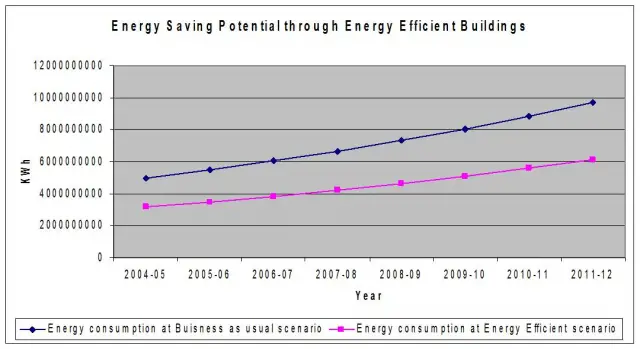
Green Building
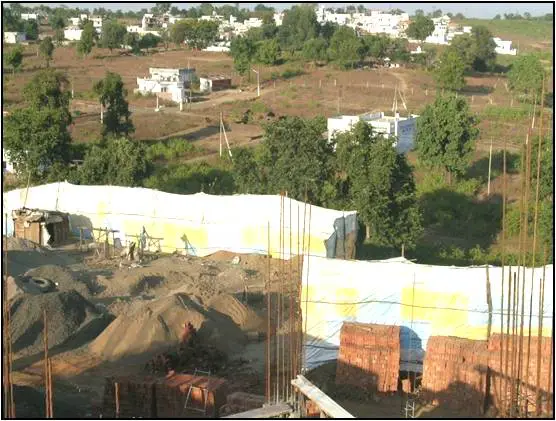
- Green buildings achieve thermal and visual comfort using nature’s energy sources and minimal impact on environment.
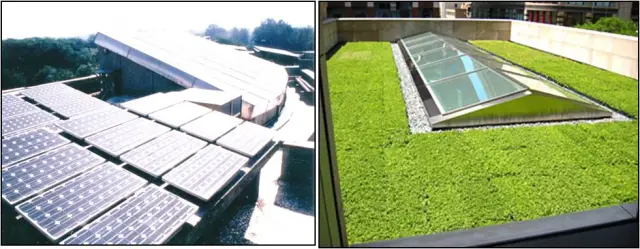
- Are passive buildings using nature’s sources through architecture, are energy efficient and maximize use of renewable sources of energy.

- Use very less water and promote recycling and reuse of water.
- Enable solid waste segregation, management and generation of resources from wastes.
ENABLING MECHANISMS
Policies/Programs To Mainstream Green Construction
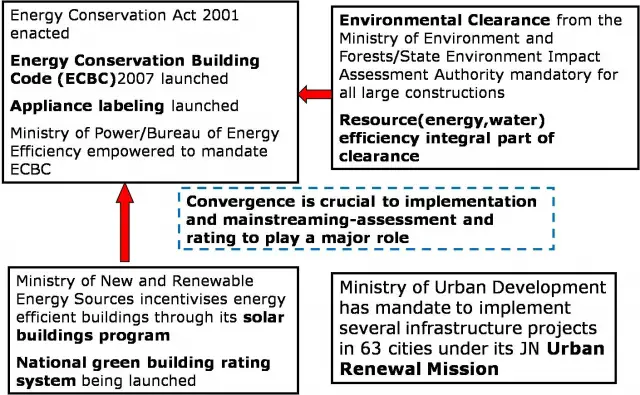
GRIHA-Green Rating for Integrated Habitat Assessment
- Tool to facilitate design, construction, operation of a green building ,and in turn ….measure “greenness” of a building in India.
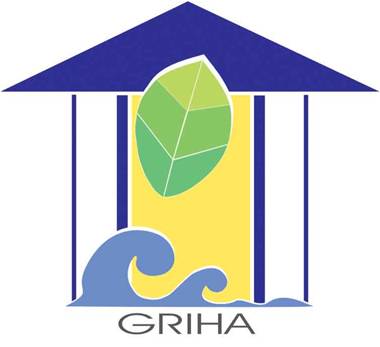
What gets measured gets managed.
KEY HIGHLIGHTS
- Sets performances benchmarks for key resources like, energy and water.
- Facilitates integration of traditional knowledge on architecture with present day technology.
- Integrates all relevant Indian codes and standards(e.g National building code 2005, Energy Conservation Building Code 2007, IS codes).
- Is in complete alignment with government policies and programs (e.g Environmental clearance by the MoEF).
- GRIHA criteria attempts to enhance thermal comfort in non AC spaces by use of passive/low energy consuming options.
GRIHA – National Rating System
- Rating for Building types:
- Commercial
- Residential
- Industrial
- Climate Zones
- 5 climatic zones
GRIHA – Green Rating for Integrated Habitat Assessment
- Provides guidelines, best practices, benchmarks/ indicators:
- Conservation of for soil, energy, water, materials.
- Demand reduction.
- Enhanced efficiency level of water use, energy use.
- Use of renewable energy resources.
- Maximizing recycling and reuse of water and waste.
- Ensuring quality of water, and air (outdoor and indoor).
- Ensuring safety , health of construction workers.
- Quality of indoor environment.
- Controlling factors leading to climate change.
- SET OF 32 CRITERIA
- 100 point system with differential weight-age on various criteria.
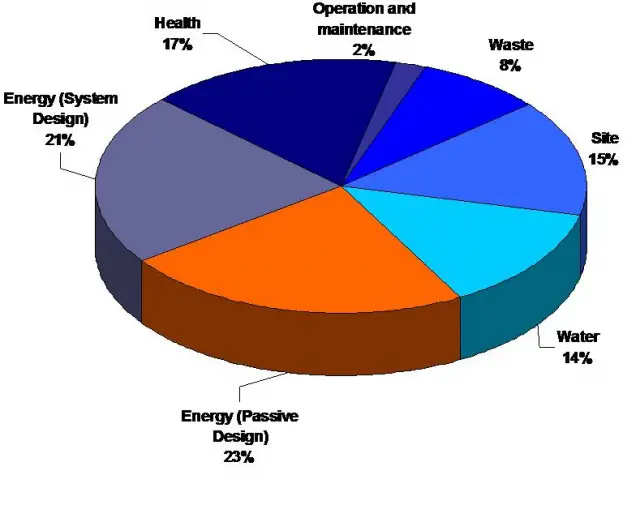
PIE CHART SHOWING THE DISTRIBUTION OF POINTS AMONG DIFFERENT FACTORS
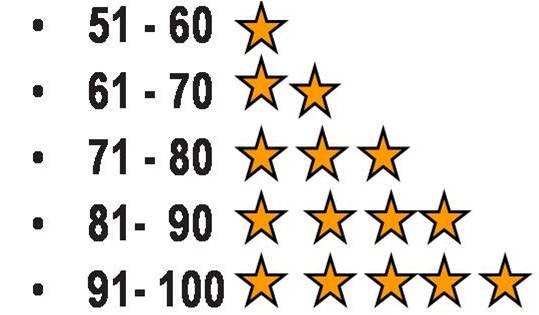
POINT RATING SYSTEM
- CASE STUDY
- Centre For Environmental Sciences & Engineering Building, IIT, Kanpur
SITE PLANNING- Resource conservation and enhanced efficiency.
- Preserve ,protect landscape during construction:
- Proper timing of construction to minimise erosion.
- Preserve existing trees/vegetation.
- Preserve top soil.
- Measures to collect/divert runoff from polluted areas so that it does not mix with storm water run off from undisturbed areas.
- Run off control measures like contour trenching, mulching.
- Spill prevention and control plans to stop source of spill, to dispose contaminated and hazardous wastes.
- Soil and water conservation (post construction)
- Proper soil erosion and sedimentation control plan.
- Proper laying back of top soil for vegetative growth.
- Soil stabilization.
- Storm water management and filtration.
- Compensatory depository forestation for removed mature trees
- Replant the number of mature trees removed in higher ratio (1:3).
- Minimize site circulation and provide aggregate utility corridor.
- Minimize road and pedestrian walkway length.
- Provide single utility corridor.
- Reduce hard paving on site.
- Restricted paved area.
- Net imperviousness not to exceed NBC limits.
- Surface parking not to exceed local bye law limits.

- Design in sync with site features.
- Harness onsite natural resources-solar, wind, water etc.
- Appropriate zoning to take benefit of natural site conditions.
- Measures to ensure that other buildings’ solar, wind access is not hampered.
- Energy efficient site lighting and lighting though renewable energy sources.
- Meet minimum luminous efficacy.
- Usage of solar lighting system.
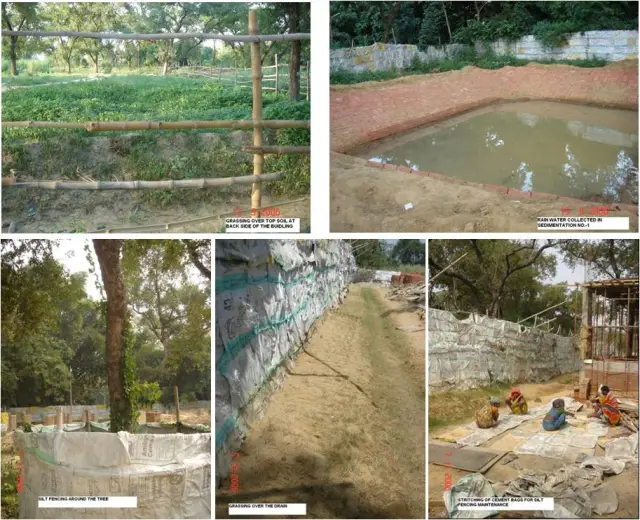
Sustainable Site Planning Practices
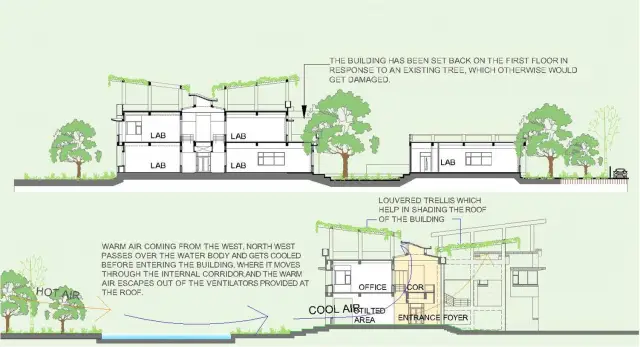
Criteria 3: Design To Include Existing Site Features
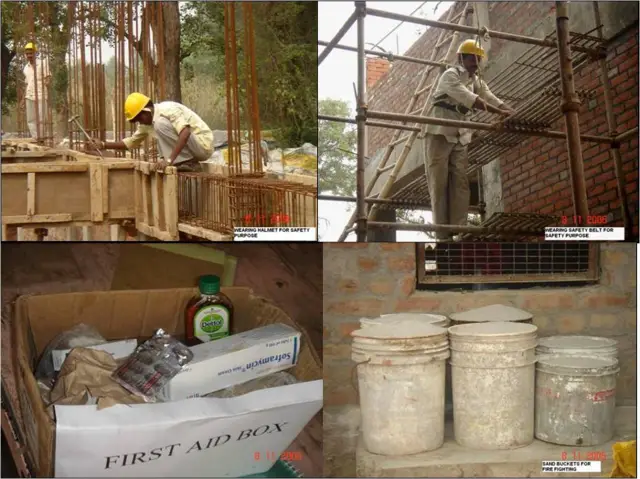
Criteria 7: Safety Facilities For Construction Workers
WATER
- Reduce water consumption in landscaping by 30-50%.
- Adopt measures to reduce water consumption in landscaping.
- Progressive reduction in water consumption to fetch more points.
- Reduce water use in buildings.
- Reduce water use over the baseline consumption with conventional fixtures by 25-50%.
- Progressive reduction in water consumption to fetch more points.
- Efficient water use during construction.
- Adopt measures to minimise potable water use during construction.
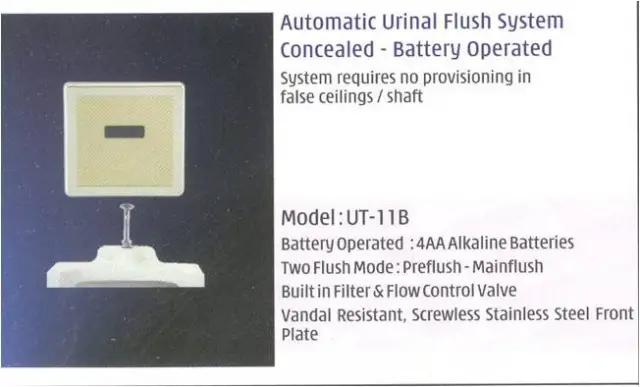
Criteria 10: Reduction In Water Use By Building
- Water saving reduction by 50%
- CESE building, IIT, Kanpur achieves 60%.
ENERGY
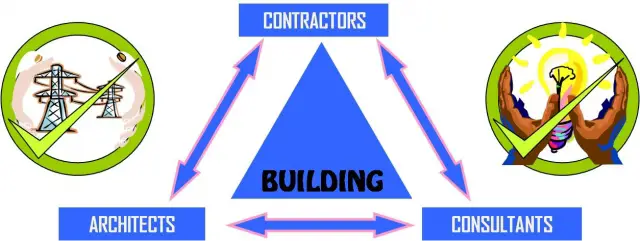
- GRIHA is unique in comparison to international rating systems because it stresses on the use of passive architectural practices rather than relying on energy intensive air-conditioning systems and practices.
- The maximum points are reserved for the two criteria dealing with passive design practices and energy efficiency.
- Objective of Criteria 12
- “To apply solar passive measures including day lighting to reduce the demand on conventional energy for space conditioning and lighting systems in buildings.”
- Criteria 13
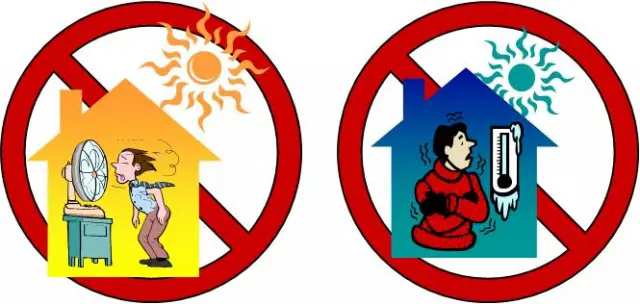
- Optimise Energy Performance Of Building Within Specified Comfort
- Follow mandatory compliance measures (for all applicable buildings) as recommended in the Energy conservation building code
- Non-air conditioned areas should satisfy thermal comfort conditions as specified in the National Building Code, Bureau of Indian Standards, Part–8 Building services; Section 1 -Lighting and ventilation; Desirable wind speeds m/s for thermal comfort conditions, Table 9 and 10
- Air conditioned areas’ thermal comfort conditions as specified in the National Building Code, 2005 ,Bureau of Indian Standards Part-8 Building Services; Section 3- Air conditioning, heating and mechanical ventilation, Section 4.4.3 inside design conditions are met for 100% of all occupied hours.
Solar Passive Architectural Design Strategies
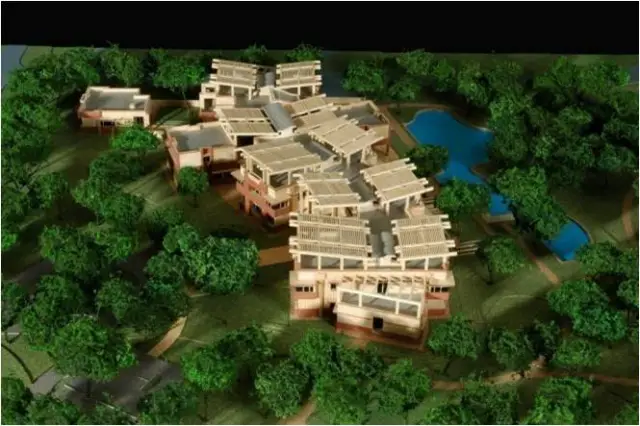
- Water body to cool the micro climate.
- Orientation of building : North – South.
- External shading devices : Shaded roof and windows.
- Optimized window design by selection of Low E glass and external shading.
- Daylight integration in all living spaces.
Optimization Of Building Material & Selection
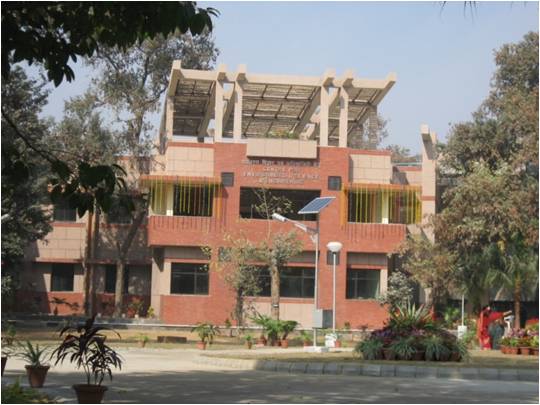
| INITIALLY |
LATER |
| Brick wall | Cavity brick wall with insulation. |
| RCC roof without insulation | Roof insulation with fiber glass. |
| Single clear glass for windows | Shading on roof. (Double glass for windows.) |
Initial energy consumption: 240 kWh/m2 yr
Energy consumption Later: 208 kWh/m2 yr
13% ENERGY SAVINGS
Optimization of Lighting Design
- Efficient fixtures
- Efficient fixtures & lamps
- Efficient layout
- Daylight integration
Achievement
- LPD=1.3W/ft2
- Illumination levels as per standards:
- Laboratory: 400 lux
- Corridors: 200 lux
- Work plane (faculty room): 300 lux
Initial energy consumption: 208 kWh/m2 yr
Energy consumption Later: 168 kWh/m2 yr
19% ENERGY SAVINGS
Optimization Of HVAC System
| INITIALLY |
LATER |
| Air-cooled chiller | Water-cooled chiller CoP=4.88 (complying with minimum efficiency requirements of the Energy Conservation Building Code) |
Initial energy consumption: 168 kWh/m2 yr
Energy consumption Later: 133 kWh/m2 yr
21% ENERGY SAVINGS
Low Energy Strategies
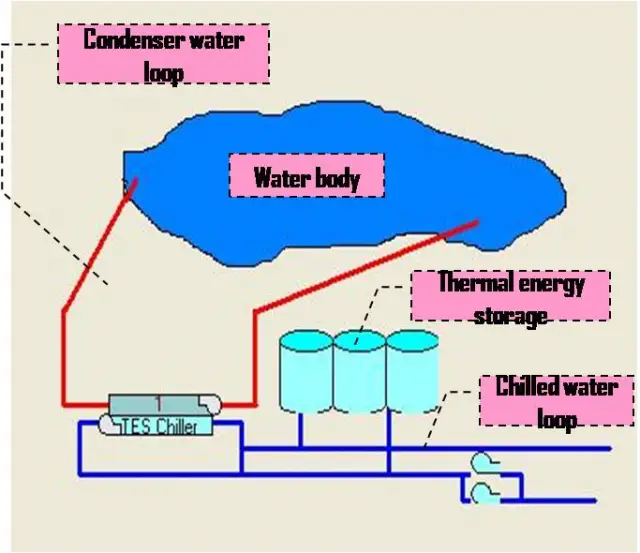
Optimization Of HVAC Design
| INITIALLY |
LATER |
| No controls used in HVAC system |
|
Initial energy consumption: 133 kWh/m2 yr
Energy consumption Later: 98 kWh/m2 yr
26% ENERGY SAVINGS
Annual Energy Savings
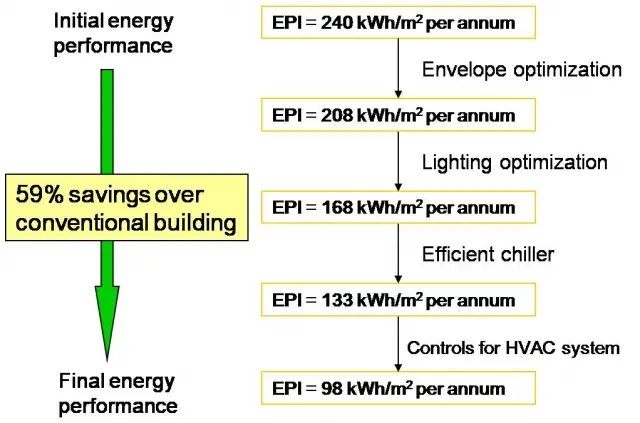
Renewable Energy Integration

| Criteria-17 | Renewable Energy
|
| Criteria-18 | Renewable Energy Based Hot Water System
|
Efficient Waste Management
| Criteria-21 | Reduction in waste during construction. |
| Criteria-22 | Efficient waste segregation. |
| Criteria-23 | Storage and disposal of waste. |
| Criteria-24 | Resource recovery from waste. |
Most of the waste generated in urban areas finds its way to expansive sanitary landfills.
GRIHA expects adoption of methods that will ensure reduced waste generation and improved waste management.
These methods are incorporated in the building process from conception (pre construction) through functioning.
This further eases the process of recycling of wastes and reusing biodegradable wastes for purposes such as composting and organic farming.
Health And Well Being
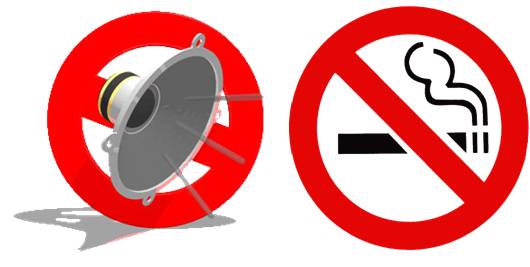
| Criteria-25 | Use of low VOC paints/ adhesives/ sealants. |
| Criteria-26 | Minimize Ozone depleting substances. |
| Criteria-27 | Ensure Water Quality
|
| Criteria-28 | Acceptable outdoor and indoor noise levels
|
| Criteria-29 | Tobacco and smoke control. |
Building Operation and Maintenance
| Criteria-30 | Energy Audit And Validation
|
| Criteria-31 | Operations and Maintenance protocol for electrical and mechanical equipment. |

I would like to know about
I would like to know about Lux level in Parking? Height is 12 feet. So please Suggest Minimum & Maximum lux.
Waiting for your reply
Bhushan
9860571358